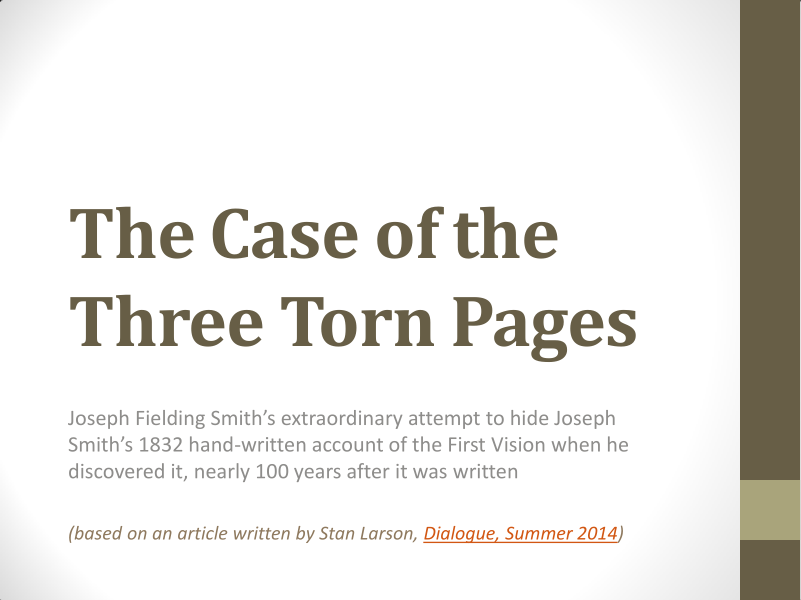"Mormon Stories" article argues that the evidences supports Joseph Fielding Smith, or someone under his charge in the Church Historian's Office, tearing out the 3 pages of Letterbook 1.
- Type
- Website
- Source
- Mormon Stories Critic
- Hearsay
- Direct
- Reference
"The Case of the Three Torn Pages," Mormon Stories, January 2019, accessed June 9, 2022
- Scribe/Publisher
- Mormon Stories
- People
- Stan Larson, Brigham Young, Sandra Tanner, Jerald Tanner, Levi Edgar Young, Mormon Stories, Joseph Smith, Jr., LaMar Petersen, Paul R. Cheesman, Joseph Fielding Smith
- Audience
- Reading Public
- Transcription
The Case of the Three Torn Pages
Joseph Fielding Smith’s extraordinary attempt to hide Joseph Smith’s 1832 hand-written account of the First Vision when he discovered it, nearly 100 years after it was written
(based on an article written by Stan Larson, Dialogue, Summer 2014)
Discovery of the 1832 Version
• 1832 – Joseph Smith records his hand-written history including an account of the First Vision and the coming forth of the Book of Mormon
in first three (2-sided) pages of Letterbook 1
• 1838/39 – Official account of First Vision is published
• Later canonized in Pearl of Great Price in 1880
• 1844 – Joseph Smith killed in Carthage, IL
• 1847 – Brigham Young and saints trek to Utah, bring boxes of Church records to Salt Lake City (including Letterbook 1)
• 1901 – Joseph Fielding Smith (JFS) began work in Church Historian and Recorder office
• 1910 – JFS called as Apostle
• 1921 – JFS called as Church Historian
• ~1921-1935 – JFS and Church Historian office process box of Nauvoo records, discover Letterbook 1(approximately 100 years after it was
created)
• ~1930-35 - Three pages containing JS’s 1832 handwritten history are excised out of Letterbook 1 and placed in JFS’s office safe
• Rest of Letterbook 1 and other Nauvoo records placed in Church archives
JFS Shares Three Pages w/ Confidant
• 1940s-early 50’s – JFS shows Levi Edgar Young, president of the First Council of the Seventy, the excised pages
• 1952/53 – Amateur historian LaMar Petersen interviews Levi Edgar Young about this experience. Young says:
• Church should have committee to answer hard questions
• He quit going down with his own questions to JFS “because he was laughed at and put off”
• He asked to see documents, “Told to get higher permission”
• Obtained permission, examined documents, “Was told not to copy or tell what they contained”
• Said it was a “strange account” of First Vision
• 1963 – Levi Edgar Young dies - Petersen keeps information confidential until then
JFS’s Hand Forced by Tanners
• Early 1964 - Peterson tells Jerald & Sandra Tanner about “strange account” of First Vision
• Tanners write to JFS asking to see the 1832 account
• JFS refuses their request
• JFS or someone in his office then moves three excised pages from private safe to the regular Church Historian’s collection and someone tapes the 3 pages back in Letterbook 1
• JFS authorizes Assistant Church Historian to show restored Letterbook 1 to BYU graduate student, Paul R. Cheesman
• 1965 – Cheesman prepares typescript of masters thesis
• An Analysis of the Accounts Relating Joseph Smith's Early Visions
• Tanners are first to publish text of 1832 account, based on imperfect transcript in Cheesman’s thesis
Church publishes digital scans of Letterbook 1 in early 2010’s
• Reinsertion of excised pages is very evident
• Excision is acknowledged but not explained by Joseph Smith Papers project staff
Who Tore Out the Pages? Why?
• Who?
• Evidence strongly points to Joseph Fielding Smith or at least someone in the Church Historian's office, under his charge.
• Why?
• JS’s hand-written version differed from the canonized 1838 version
• 1832 - JS already knew no churches were right, seeks forgiveness from sins, single personage “The Lord” (Christ )appears, forgives JS
• 1838 – JS seeks which church to join, Father and Son appear, tells JS to join none of churches
• This struck at heart of Joseph Smith’s claim of being divinely called to restore True Church. JFS may have feared fallout
Why is this incident significant?
The Church is widely accused of whitewashing/hiding any history that is not “faith promoting”
• This is a very specific example of an important, historical document being withheld from history for over 30 years.
• Evidence strongly points to JFS, or someone in his office, excising Joseph Smith’s hand-written 1832 account of the First Vision from the book that contained it, and hiding it in his private safe (away from the already tightly held Church archives—only to reinsert it in the archived book over 30 years later, when news of its existence started to mount.
- Citations in Mormonr Qnas
The B. H. Roberts Foundation is not owned by, operated by, or affiliated with the Church of Jesus Christ of Latter-day Saints.

